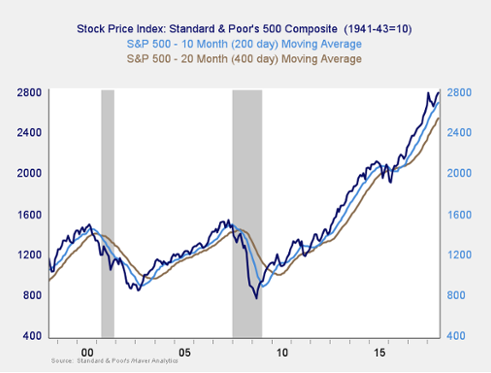Signal: Yellow light
Risk factor #3: Technical factors. A good way to track overall market trends is to review the current level versus recent performance. Two metrics I follow are the 200- and 400-day moving averages. I start to pay attention when a market breaks through its 200-day average, and a break through the 400-day often signals further trouble ahead.

These indicators remain positive, with all three major U.S. indices above both trend lines. The Dow did briefly drop through its 200-day in June. In the past couple of months, we have also seen the S&P 500 bounce off its 200-day on a daily basis several times, which could be a sign of weakness. But looking at monthly signals, as this chart does, there has not been a sustained break. With no convincing movement either way, the risk of the trend turning negative has risen materially. The most probable case is that the markets continue to rise, as they failed to break support even at the nadir. But given the fact that both the Dow and the S&P have hit their support levels—and have not yet convincingly rebounded above—risks of more volatility have increased. So, I am keeping this indicator at yellow.
Signal: Yellow light
Conclusion: Risks Rising, Conditions May Be Weakening
After taking the market risk indicator to a yellow light for the first time four months ago, markets have since recovered. This recovery was more or less expected. At the same time, the yellow light rating recognized that risks have risen. Despite the recovery, and the fact that we are once again approaching new highs, those risks are still there.
The overall economic environment remains supportive, and neither of the likely shock factors is necessarily indicating immediate risk. But the continued volatility and the fact that several of the market indicators point to an elevated level of risk—combined with the ongoing policy concerns—suggest that volatility may get worse.
As such, we are keeping the overall market indicator at a yellow light. This is not a sign of immediate trouble. Indeed, the likelihood remains that the market will keep moving higher. Rather, it is a recognition that the risk level has increased materially and that, even as the market recovers, further volatility is quite likely.
Brad McMillan is the chief investment officer at Commonwealth Financial Network, the nation’s largest privately held independent broker/dealer-RIA. He is the primary spokesperson for Commonwealth’s investment divisions. This post originally appeared on The Independent Market Observer, a daily blog authored by Brad McMillan.








